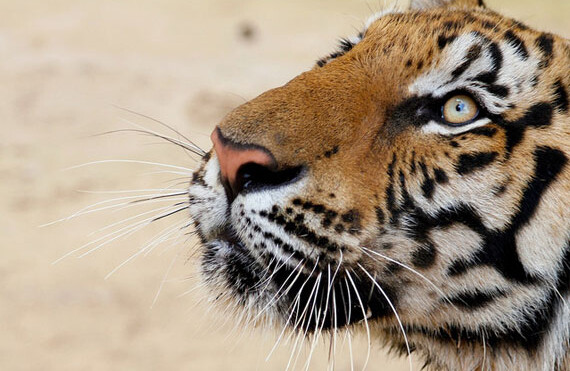Their funeral pyres were lit with fire from the palace of the King of Thailand.
Protecting tigers and elephants is risky business in Thailand. Poachers are armed and well financed, but efforts to safeguard the Huai Kha Khaeng Wildlife Sanctuary have led to a steady rise in tiger numbers since 2007, with a record 50+ tigers counted in 2012.
I began working to preserve Thailand's wildlife in the late 1980s when I served with the Thai government as superintendent of two protected areas. Part of my job was to conduct patrols in the field, confronting people undertaking all manner of illegal activities, including serious offenses such as poaching high-value species. In 2004, I became director of the Wildlife Conservation Society program in Thailand.
It was well known at the time that wild tigers across Asia were facing a dire threat. We made it a priority at WCS to conserve the tigers of the Western Forest Complex, particularly in Huai Kha Khaeng. Over the past decade, camera traps set up by WCS scientists and the government of Thailand have helped us to monitor tiger populations and provide evidence against poachers who attempt to remove them from the sanctuary.
Meanwhile, government officials in Thailand, with some financial and technical support from WCS, have bolstered anti-poaching patrols and enforcement in Huai Kha Khaeng and neighboring protected areas. The relationship between WCS and the government of Thailand continues to be positive and fruitful, and we are encouraged to provide advice and support.

Tigers, such as this well-fed male photographed in January 2014, are thriving inside Huai Kha Khaeng.
A STRONG CONVICTION
The Thai government sent a strong message to criminal gangs in 2012 when it sentenced two poachers to prison. Photo evidence found on one of the men's cell phones led to their conviction after a lengthy trial. The poachers had posed over a dead tiger with AK-47s in hand, and researchers were able to confirm the identity of the dead tiger by examining the stripe pattern depicted in the cell phone photo—a pattern that is unique to each tiger.
 Incriminating evidence was found on the cell phone of an arrested poacher.
Incriminating evidence was found on the cell phone of an arrested poacher.
The tiger had been tracked by scientists from the government of Thailand and WCS in Thailand's Western Forest Complex, where a camera trap had snapped its image. The poachers alleged that the tiger had been shot in neighboring Myanmar, but the matching stripe pattern proved otherwise. The maximum distance that tiger could have moved was about 22 kilometers. It was impossible for the poacher to hunt this tiger in Myanmar as claimed because the distance was more than 60 kilometers from the tiger's last sighted location in July 2010.
One of the poachers, a Thai Hmong, was sentenced to five years in jail, while the other, a Vietnamese citizen, was sentenced to four years—the most severe punishments for wildlife poaching ever handed down in Thailand.
ANOTHER TOOL IN THE BOX
Another key component for protecting tigers in Thailand is the use of an open-source ranger patrol data management system called SMART (Spatial Monitoring and Reporting Tool). As my colleague Emma Stokes wrote for Policy Innovations in 2013, the aim of SMART is to incorporate science into enforcement efforts across the globe. In particular, both the intensity of threats to wildlife and the performance of ranger patrols are rigorously and scientifically tracked by the system.
The SMART program seeks to ensure: adequate numbers of patrol staff; good equipment and support; high-quality training; standardized law enforcement monitoring; a strong intelligence network to help guide patrols; and the integration of law enforcement data with planning and deployment of patrols.
A FIGHT IN THE FOREST
In fall 2013, rangers in Huai Kha Khaeng picked up the trail of a poaching gang after finding the carcasses of a leaf monkey and other wildlife. Two rangers were killed in the gunfight that ensued and two others had to be evacuated for advanced medical treatment. The dead were given high honors by the Thai government and their funeral pyres were lit with fire from the palace of the King of Thailand, a great honor.
After the gunfight, two poachers were arrested and interrogated. They indicated that tigers had been their prime target but said they had not been successful in catching either tigers or elephants during their two weeks in the Western Forest Complex. Their interrogation also yielded the names and homes of two other poachers who were still at large.

Highly trained ranger patrol teams with good morale are key to the recovery of tigers and other wildlife in Thailand.
REASONS FOR HOPE
The loss of the rangers was heartbreaking. Yet the honor bestowed on the deceased men and the fast-tracking of the cases by the judiciary are hopeful signs. Conservationists have a proactive partner in the Thai leadership. At the same time, the efforts of the rangers led to the speedy capture and breakup of a criminal poaching gang before it could kill more wildlife.
All of these approaches I have described play a vital role in safeguarding Thailand's tigers: scientific data, government partnership, new technologies, judiciary enforcement, and honor for the fallen and the brave.
Over the past 10 years, the population of big cats in Huai Kha Khaeng has steadily increased, and many tigers are also dispersing from Huai Kha Khaeng into neighboring protected areas, a further hopeful sign. WCS will continue to work with the Thai government as it endeavors to stabilize and expand the populations of threatened wildlife in Southeast Asia.
Anak Pattanavibool is country director for the Wildlife Conservation Society's Thailand Program.





